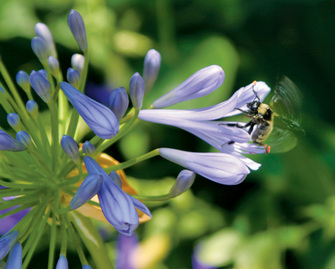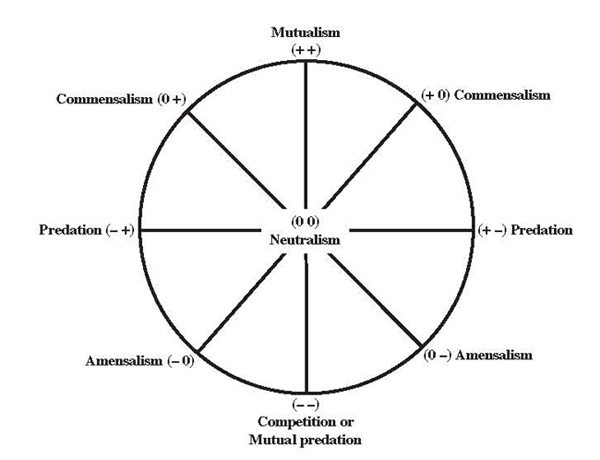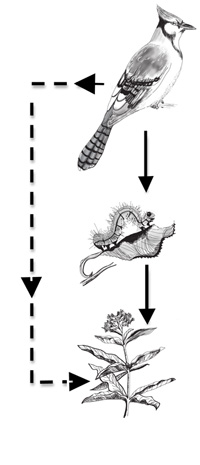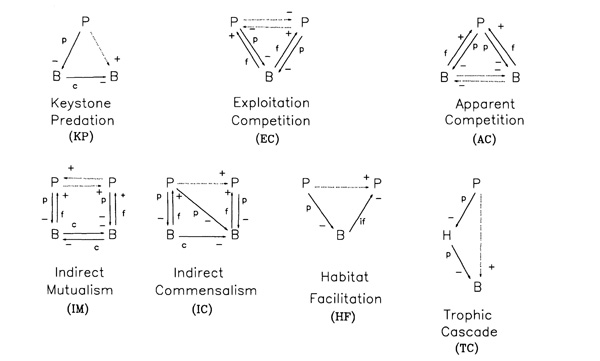« Prev Next »
Direct Effects

Competition: Competition occurs when two organisms compete for the same resource (food, space, mates, etc.). Both individuals are negatively impacted by competition for the resource because either the resource is limited or, if the resource is not limited, they can physically interfere with competitors attempting to obtain the resource.
Predation: Predation takes place when one organism (the predator) consumes another (the prey). Typically, carnivores, such as the cheetah pursuing the gazelle mentioned above, are excellent examples of predation. In its broadest sense, the term predation includes all consumption of another organism for nutrients, including herbivory and parasitism. However, as the latter have some unique characteristics, they are often considered independently of predation.
Herbivory: When a plant is eaten by another organism, it is considered herbivory. Unlike predation, in which the whole organism is destroyed, plants often survive grazing by an herbivore. For this reason, herbivory is sometimes referred to as plant parasitism.
Parasitism: A parasite is physiologically dependent upon its host for nutrition. While the host is negatively affected by the loss of nutrients to the parasite, parasitism rarely leads directly to the host's death. Unfortunately, humans are hosts to any number of parasites, including liver flukes, tapeworms, lice, pinworms, giardia, and many others.
Mutualism: In a mutualism, both partners benefit from the relationship. Many coral reefs have "cleaning stations" where some species of fish remove parasites from other fish. The cleaner fish get nutrition from the consumed parasites while the cleaned fish enjoy freedom from their parasites.
Commensalism: Commensalism occurs when one organism is positively affected by the relationship while the other organism is not affected, either negatively or positively, by the interaction. Cattle egrets who feed on the insects stirred up by domesticated cattle are an example of commensalism. Some birds have even taken advantage of the invention of the lawn mower to extend this relationship to the suburban lawn.
Amensalis: Amensalism takes place when one individual is negatively affected by interaction with another individual who is not affected by the relationship. Many molds, including Penicillium, secrete chemicals that kill bacteria in their vicinity.
Neutralism: Interactions between the two individuals are neutral in regards to both species. Some bacteria may exhibit neutralism as it has been reported that some species of Lactobacillus and Streptococcus can coexist without affecting each other positively or negatively. However, it has been suggested that true neutralism is probably rare in nature.
|
Interaction
|
Species X
|
Species Y
|
| Mutualism | + | + |
| Commensalism | + | 0 |
| Predation | + | - |
| Herbivory | + | - |
| Parasitism | + | - |
| Amensalism | 0 | - |
| Competition | - | - |
| Neutralism | 0 | 0 |
|
Table 1: Classic categories of direct effects in ecological communities
The sign (+, - , 0) represents the net effect of one species on the other species, either positive, negative, or neutral. | ||
While the relationships between large carnivores and their prey are easily placed in one of the categories of direct effects, many associations between two organisms or species involve multiple types of interaction, which may shift along a continuum from one category to another. Recently direct effects have been more accurately portrayed as an interaction compass (Figure 2; Holland & DeAngelis 2009). Depending on biotic and abiotic factors affecting the individuals, the true relationship may fall in between the set categories, and even shift between categories over time. For example, a well documented mutualism is the ant-plant interaction (reviewed in Heil & McKey 2003). Plants provide domatia and/or nectar for the ants and receive protection from insect herbivores and plant competitors in return. However, ants may also castrate the flowers and fruits of their resident plant, skewing plant resource partitioning to growth rather than reproduction and thereby increasing nectaries and domatia (Yu & Pierce, 1998). If the ants become too aggressive in their pruning behaviors, the relationship between the ants and plant may shift from mutualism to parasitism. As a means to "cheat the cheater," some plants have fought back by relocating flower production away from nectaries and domatia to reduce ant visitation to fruiting areas, which swings the compass once more toward a mutualistic relationship (Yu & Pierce 1998; Izzo & Vasconcelos 2002).

Indirect Effects

The second, interaction modification, occurs when the donor species alters some other attribute of the transmitter, such as behavior. When predation threatens a prey species, the prey often modify their behavior in order to reduce the chances of coming under the attention of the predator. Dragonfly nymphs are voracious aquatic predators whose prey sometimes include dragonfly nymphs of a different species. When these two predators (one of which will also prey on the other) are given a common prey species, the dragonfly nymph prey often alters its behavior by reducing its activity to avoid predation by the top predator. The combined effects of the dragonfly nymph prey's reduced activity and a shift to some predation of the dragonfly nymph prey by the top predator can reduce the mortality rate of the shared prey item (Wissinger & McGrady 1993; Crumrine & Crowley 2003).
Indirect effects consist of a sequence of at least two direct effect steps. Menge (1995) identified seven classic models of these sequences, and identified two new models during his research (Figure 4).
Keystone Predation: A series of classic ecological experiments by Paine in the 1960s helped to elucidate this indirect effect model. In keystone predation, the removal of a prey species by the predator indirectly increases the abundance of a competitor of the prey species. Menge (1995) found that keystone predation was the most common of the indirect effects observed in intertidal studies with 35% of the interactions falling in to this model.
Exploitation Competition: When two predators consume the same prey, the loss of abundance in the prey species can negatively affect the second predator. Menge (1995) found that exploitive competition was the least common interaction, appearing only 2.8% of the time.
Apparent Competition: Apparent competition occurs when an increase in the abundance of one species leads to a decrease in the abundance of a second species due to enhanced predation by a shared predator. Apparent competition was the second most common indirect effect category, comprising 25% of the total interactions in intertidal communities (Menge 1995).
Indirect Mutualism: An indirect mutualisum takes place when positive effects on two consumer species when each negatively impacts a competitor species of the other predator's main prey species.
Indirect Commensalism: Indirect commensalism is similar to indirect mutualism except that one of the predator species will also consume the main prey of the other predator species.
Habit Facilitation: In habitat facilitation, one species indirectly improves the habitat of a third species by its interactions with a second species.
Trophic Cascade: The example above of the bird/caterpillar/plant relationship is an example of a trophic cascade. The plant is positively affected by the decrease in herbivory caused by a predator reducing herbivore numbers.
Indirect Defense: Indirect defense occurs when a non-prey species leads to the indirect decrease of a consumer species either by reducing the prey species via competition, which leads to a reduction in the consumer species, or when one prey species leads to an increase in its predator abundance, which then preys more heavily on the third species.
Apparent Predation: Apparent predation can occur by two avenues: a non-prey individual that has an indirect positive effect on a consumer or the negative effect of a predator on a non-prey species.

The detection of indirect effects can be complicated in ecological experiments due to the fact that responses can contain a mix of direct and indirect effects. By using the appropriate experimental design and data collection, it is possible to isolate and test pathways. One way to approach the detection of indirect effects is a press versus pulse design (Bender et al. 1994). In a press experiment, the experimental manipulation is sustained whereas in a pulse experiment the perturbation is transient. Theoretically, press experiments should evidence both direct and indirect effects while pulse experiments should only present direct effects. However, some indirect effects can occur quickly (Menge, 1997), so alternative methods for detection of indirect effects, such as path analysis, are needed (Wootton, 1994).
Do direct or indirect effects have a greater impact in structuring communities? In a review of experimental studies, Schoener (1993) reported that only about one quarter of all community change reported resulted from indirect effects while the remainder resulted from direct effects. This review seemed to support the view that indirect effects were not very important relative to direct effects. Menge (1995), however, reported that, on average, 40–45% of all community change in intertidal food webs resulted from indirect effects and that in individual studies the percentage could be as high as 65%. Thus, it seems that the relative roles of these factors vary among studies and that under certain circumstances indirect effects could be exerting as strong an influence on community structure as direct effects.
References and Recommended Reading
Bender, E. A., Case T. J., et al. Perturbation experiments in community ecology: theory and practice. Ecology 65, 1–13 (1984).
Crumrine, P. W. & Crowley, P. H. Partitioning components of risk reduction in adragonfly-fish intraguild predation system. Ecology 84, 1588–1597 (2003).
Heil, M. & McKey, D. Protective ant-plant interactions as model systems in ecological and evolutionary research. Annual Review of Ecology, Evolution, and Systematics 34, 425–453 (2007).
Holland, J. N. & DeAngelis, D. L. Consumer-resource theory predicts dynamic transitions between outcomes of interspecific interactions. Ecology Letters 12, 1357–1366 (2009).
Izzo, T. J., Heraldo, L., et al. Cheating the cheater: domatia loss minimizes the effect of ant castration in an Amazonian ant-plant. Oecologia 133, 200–205 (2002).
Menge, B. A. Indirect effects in marine rocky intertidal interaction webs: patterns and importance. Ecological Monographs 65, 21–74 (1995).
Menge, B. A. Detection of direct versus indirect effects: were experiments long enough? American Naturalist 149, 801 (1997).
Schoener, T. On the relative importance of direct versus indirect effects in ecological communities. In Mutualism and Community Organization: Behavioral, Theoretical, and Food Web Approaches, Kawanabe, H., Cohen, J. E. & Wasaki, K., eds. (Oxford: Oxford University Press, 1993): 365–411.
Wissinger, S. & McGrady, J. Intraguild predation and competition between larval dragonflies: direct and indirect effects on shared prey. Ecology 74, 207–218 (1993).
Wootton, J. T. Indirect effects and habitat use in an intertidal community: interaction chains and interaction modifications. American Naturalist 141, 71–79 (1993).
Wootton, J. T. The nature and consequences of indirect effects on ecological communities. Annual Review of Ecology and Systematics 25, 443–466 (1994).
Yu, D. W. & Pierce, N. E. A castration parasite of an ant-plant mutualism. Proceedings of the Royal Society London B 265, 375–382 (1998).































